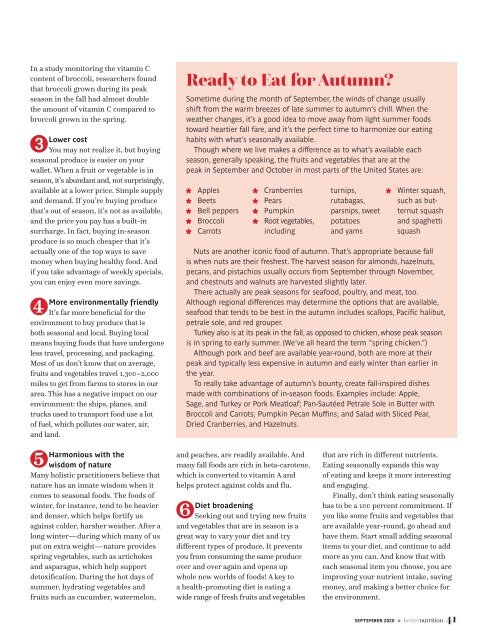You also want an ePaper? Increase the reach of your titles
YUMPU automatically turns print PDFs into web optimized ePapers that Google loves.
In a study monitoring the vitamin C<br />
content of broccoli, researchers found<br />
that broccoli grown during its peak<br />
season in the fall had almost double<br />
the amount of vitamin C compared to<br />
broccoli grown in the spring.<br />
Lower cost<br />
You may not realize it, but buying<br />
seasonal produce is easier on your<br />
wallet. When a fruit or vegetable is in<br />
season, it’s abundant and, not surprisingly,<br />
available at a lower price. Simple supply<br />
and demand. If you’re buying produce<br />
that’s out of season, it’s not as available,<br />
and the price you pay has a built-in<br />
surcharge. In fact, buying in-season<br />
produce is so much cheaper that it’s<br />
actually one of the top ways to save<br />
money when buying healthy food. And<br />
if you take advantage of weekly specials,<br />
you can enjoy even more savings.<br />
More environmentally friendly<br />
It’s far more beneficial for the<br />
environment to buy produce that is<br />
both seasonal and local. Buying local<br />
means buying foods that have undergone<br />
less travel, processing, and packaging.<br />
Most of us don’t know that on average,<br />
fruits and vegetables travel 1,300–2,000<br />
miles to get from farms to stores in our<br />
area. This has a negative impact on our<br />
environment: the ships, planes, and<br />
trucks used to transport food use a lot<br />
of fuel, which pollutes our water, air,<br />
and land.<br />
Ready to Eat for Autumn?<br />
Sometime during the month of September, the winds of change usually<br />
shift from the warm breezes of late summer to autumn’s chill. When the<br />
weather changes, it’s a good idea to move away from light summer foods<br />
toward heartier fall fare, and it’s the perfect time to harmonize our eating<br />
habits with what’s seasonally available.<br />
Though where we live makes a difference as to what’s available each<br />
season, generally speaking, the fruits and vegetables that are at the<br />
peak in September and October in most parts of the United States are:<br />
* Apples * Cranberries<br />
* Beets * Pears<br />
* Bell peppers * Pumpkin<br />
* Broccoli * Root vegetables,<br />
* Carrots including<br />
turnips,<br />
rutabagas,<br />
parsnips, sweet<br />
potatoes<br />
and yams<br />
Nuts are another iconic food of autumn. That’s appropriate because fall<br />
is when nuts are their freshest. The harvest season for almonds, hazelnuts,<br />
pecans, and pistachios usually occurs from September through November,<br />
and chestnuts and walnuts are harvested slightly later.<br />
There actually are peak seasons for seafood, poultry, and meat, too.<br />
Although regional differences may determine the options that are available,<br />
seafood that tends to be best in the autumn includes scallops, Pacific halibut,<br />
petrale sole, and red grouper.<br />
Turkey also is at its peak in the fall, as opposed to chicken, whose peak season<br />
is in spring to early summer. (We’ve all heard the term “spring chicken.”)<br />
Although pork and beef are available year-round, both are more at their<br />
peak and typically less expensive in autumn and early winter than earlier in<br />
the year.<br />
To really take advantage of autumn’s bounty, create fall-inspired dishes<br />
made with combinations of in-season foods. Examples include: Apple,<br />
Sage, and Turkey or Pork Meatloaf; Pan-Sautéed Petrale Sole in Butter with<br />
Broccoli and Carrots; Pumpkin Pecan Muffins; and Salad with Sliced Pear,<br />
Dried Cranberries, and Hazelnuts.<br />
*<br />
Winter squash,<br />
such as butternut<br />
squash<br />
and spaghetti<br />
squash<br />
Harmonious with the<br />
wisdom of nature<br />
Many holistic practitioners believe that<br />
nature has an innate wisdom when it<br />
comes to seasonal foods. The foods of<br />
winter, for instance, tend to be heavier<br />
and denser, which helps fortify us<br />
against colder, harsher weather. After a<br />
long winter—during which many of us<br />
put on extra weight—nature provides<br />
spring vegetables, such as artichokes<br />
and asparagus, which help support<br />
detoxification. During the hot days of<br />
summer, hydrating vegetables and<br />
fruits such as cucumber, watermelon,<br />
and peaches, are readily available. And<br />
many fall foods are rich in beta-carotene,<br />
which is converted to vitamin A and<br />
helps protect against colds and flu.<br />
Diet broadening<br />
Seeking out and trying new fruits<br />
and vegetables that are in season is a<br />
great way to vary your diet and try<br />
different types of produce. It prevents<br />
you from consuming the same produce<br />
over and over again and opens up<br />
whole new worlds of foods! A key to<br />
a health-promoting diet is eating a<br />
wide range of fresh fruits and vegetables<br />
that are rich in different nutrients.<br />
Eating seasonally expands this way<br />
of eating and keeps it more interesting<br />
and engaging.<br />
Finally, don’t think eating seasonally<br />
has to be a 100 percent commitment. If<br />
you like some fruits and vegetables that<br />
are available year-round, go ahead and<br />
have them. Start small adding seasonal<br />
items to your diet, and continue to add<br />
more as you can. And know that with<br />
each seasonal item you choose, you are<br />
improving your nutrient intake, saving<br />
money, and making a better choice for<br />
the environment.<br />
SEPTEMBER 2020 • 41

















